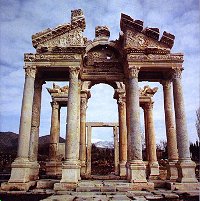Structural
and functional studies of respiratory proteins
Scientists from the Italian
Universities of Cagliari, Sassari and Roma, the Egyptian University
of Mansoura and the University of Malta, together with the Ministry
of Interior (Game Funds) of Nicosia (Cyprus) are involved in the project
indicated above in the title.
Their research work lies in structural and functional studies of respiratory
proteins such as hemoglobins, with the aim of discovering various complex
regulatory mechanisms operative at molecular level and designed to fulfil
the physiological requirement of a given species.
These mechanisms are based on the
thermodinamic connection between the binding of heterotropic effectors
(protons, CO2, chloride ions and organic phosphates) and the reaction
with O2.
 Another
important feature of the reaction of hemoglobins with O2 is its temperature-dependence,
which is governed by the associated overall enthalpy change. In the
past a lot of hemoglobins from mammals, birds, fish and other vertebrates
have been investigated by our group through comparative studies at biochemical,
physiological and molecular levels; the data obtained by this experimental
approach may provide useful information on the features involved in
the evolutionary processes of hemoglobin in vertebrates.
Another
important feature of the reaction of hemoglobins with O2 is its temperature-dependence,
which is governed by the associated overall enthalpy change. In the
past a lot of hemoglobins from mammals, birds, fish and other vertebrates
have been investigated by our group through comparative studies at biochemical,
physiological and molecular levels; the data obtained by this experimental
approach may provide useful information on the features involved in
the evolutionary processes of hemoglobin in vertebrates.
The study of Hb from red deer, for instance, whose habitat varies widely
with respect to temperature and altitude, may give further information
on molecular adaptive mechanisms to habitat, if compared to other ruminant
Hbs.
The significance of the studies
on abnormal human hemoglobin (Hb) is widely known. As "natural derivatives",
mutant Hbs provide the best example of the manner in which the structure
influences the function of a protein and expand knowledge on the role
played by each amino acid in the function of the protein.
Mutant Hbs, moreover, are useful in understanding the mechanisms of
globin gene expression, RNA processing, protein synthesis and stability,
as well as in understanding the nature, type and effect of mutations,
and so on. Qualitative hemoglobinopathies are due to a wide range of
genetic defects such as the production of structurally unstable globins
or Hb with altered O2 binding ability, both characterized by intra-erythrocytic
damages of different extent. Intra-erythrocytic changes most probably
due to alterations of the dissociation curve of a wide spectrum of variant
Hb still remain to be described. Similarly, data on the effects of an
abnormal synthesis of (normal) fetal Hb, or on the possible effects
of the presence of a mutant fetal Hb, on the fetus as well as data on
clinical and biochemical relevance of maternal Hb with high O2 affinity
on fetal pain, is insufficient.
At present, publications
due to our group are the only dealing with this biochemical aspect.
For the above reasons the interest in this field is continuing so that
some 20 new variants are described each year all over the world. In
the Italian population, the number of documented variants is 57 and
in the island of Sardinia some of them reach considerable frequencies.
The remarkable range of morphology and adaptation among animals is testified
by the diversity of structure and function of their O2-carrying proteins.
Though human Hbs received and extraordinarily higher attention and interest,
it is unequivocally recognized that a full understanding of the molecular
genetics, biochemistry, and physiology of Hbs depends on comparative
studies. Investigation and comparison of a wide span of animal Hbs provides
an impressive glimpse of molecular evolution, is of importance in understanding
associations between functional behavior and environmental adaptation,
is at the basis for the knowledge of the multiplicity of effects associated
to the presence of a particular amino acid in a particular sub-unit
position.
 This
is exceedingly important due to the high structural and functional intra-species
polymorphism displayed by several vertebrates. Amongst the number of
possible examples, the discovery of the Root effect and of its role
in some fish Hb and the observation that ovi-caprines, due to a re-activable
globin gene, are able to "switch" from the adult to a pre-adult Hb during
physiological or experimental anemia and hypoxia, represent paradigms.
The latter is an unexpected biochemical and molecular model useful in
studies on the control of gene expression. Thanks to the experience
gained in the past years (see a list of recent, selected, publications),
which allowed us to discover and study several human Hb variants and
abnormal Hbs in the human population (adult and newborn) of Sardinia
and of other Mediterranean countries in order to extend the knowledge
on epidemiological and biochemical aspects of such a genetic defects.
This
is exceedingly important due to the high structural and functional intra-species
polymorphism displayed by several vertebrates. Amongst the number of
possible examples, the discovery of the Root effect and of its role
in some fish Hb and the observation that ovi-caprines, due to a re-activable
globin gene, are able to "switch" from the adult to a pre-adult Hb during
physiological or experimental anemia and hypoxia, represent paradigms.
The latter is an unexpected biochemical and molecular model useful in
studies on the control of gene expression. Thanks to the experience
gained in the past years (see a list of recent, selected, publications),
which allowed us to discover and study several human Hb variants and
abnormal Hbs in the human population (adult and newborn) of Sardinia
and of other Mediterranean countries in order to extend the knowledge
on epidemiological and biochemical aspects of such a genetic defects.
The research activity has
the thalassemic genes, and to describe and interpret the Hb polymorphism
in some vertebrates, the research activity of our group has the object
to extend the search for additional aim of the detection of the molecular
basis responsible for the mutation by means of the sequencing of the
affected globin gene. Methods for the identification at the screening
level will be also described and proposed to researchers of developing
countries.
The study will also examine the Hb polymorphism, the structure of tetramers
and of constituent globins, the nucleotide sequence of structural genes
of the most representative vertebrates that, due to their habitat, spreading,
and phylogenetic aspects may represent useful models of evolution and
adaptation.
Considering that animals
living in geographically restricted areas may be genetically stable,
our study deals with:
a) the detection of Hb polymorphism of vertebrates living in
Sardinia, Corsica, Cyprus, Chios, Turkey, Giordania, Iran, Egypt, etc.
b) the determination of Hb structure, its ability in increasing
the polymorphism and improving adaptation to different environmental
conditions;
c) detection of globin gene sequence;
d) comparison of sequences differing in as little as one position.
The tasks of our Unit are
consistent with the application of newer methodologies for the separation
and identification of Hb and of its polymorphism, for subsequent structural
studies, identification of DNA polymorphism, sequencing of the normal
and abnormal globin gene. Result will be essential in interpreting molecular
mechanisms involved in adaptation to environment.
Copyright © 2000 -
University of Cagliari (Italy) - All right reserved


